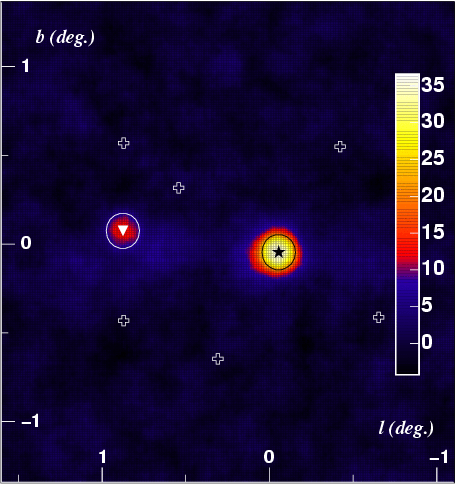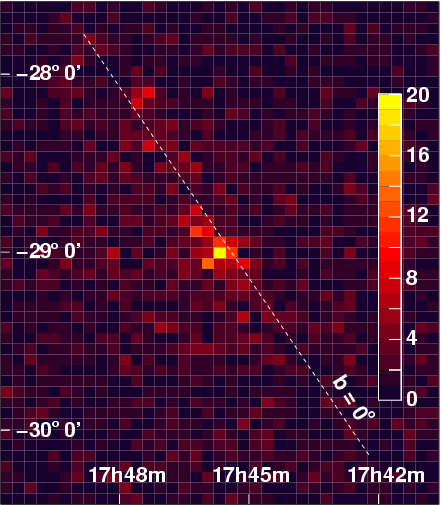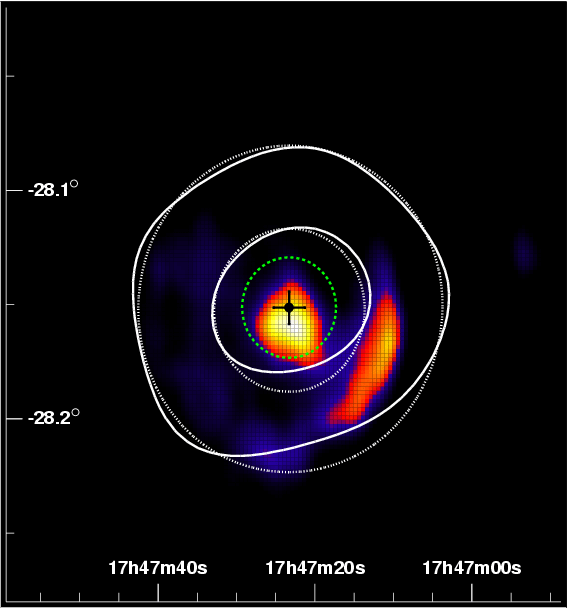
 GCNEWS
GCNEWS
A Newsletter for Galactic Center Research
This Volume was edited by Sera Markoff, Loránt Sjouwerman, Joseph Lazio, Cornelia Lang, Rainer Schödel & Robin Herrnstein
email: gcnews@aoc.nrao.edu

 GCNEWS
GCNEWS


Jim Hinton & Felix Aharonian
Max-Planck-Institut für Kernphysik, Heidelberg, Germany
hinton@mpi-hd.mpg.de, felix.aharonian@mpi-hd.mpg.de

We present an overview of the H.E.S.S. observations of the Galactic Centre region, in comparison with those of other instruments, and briefly discuss the astrophysical implications of the reported results.
The central 100 pc of our Galaxy is an extraordinary region that harbours many remarkable objects - potential sites of effective particle acceleration and copious γ-ray production. The wide field of view of the High Energy Stereoscopic System (H.E.S.S.) of imaging atmospheric Cherenkov telescopes, (5o), allows us to observe all of these candidate sources with a single pointing of the instrument.
Perhaps the most exciting of these candidates is the mysterious source Sgr A* at the kinematic centre of our galaxy. This source has now been identified as a supermassive (2.6 * 106 Mo) black hole (see e.g. [1]). Variable (non-thermal) X-ray and infrared emission from this source confirm its very compact nature. Several mechanisms for production of high energy γ-ray emission close to the event horizon of massive black holes have been suggested. These include interactions of ultra-high energy protons with the magnetic and radiation fields, as well as with the gas of the accretion flow, and curvature and inverse Compton radiation of multi-TeV electrons.
Very close to Sgr A* lies the unusually compact and powerfully supernova remnant (SNR) Sgr A East. As the prime candidate for the acceleration of cosmic rays, SNRs have long been of interest to γ-ray astronomers. The very dense medium in and around this remnant provides an enhanced target density for the production of γ-rays produced in interactions of particles accelerated in the supernova shell. This region also contains several other SNRs and pulsar wind nebulae such as G 0.9+0.1 and the so-called Mouse. Diffuse TeV emission is also expected from interactions of cosmic rays with dense molecular clouds within the central 100 pc region.

Yet another tantalizing possibility is the detection of dark matter annihilation in the central cusp in the dark matter density profile of our galaxy.
VHE γ-ray observations of this region by the H.E.S.S., CANGAROO and Whipple collaborations were published in 2004. Below we overview the HESS observations and compare our results with the results reported by the CANGAROO and Whipple groups.

The H.E.S.S. array, in the Khomas Highlands of Namibia, is the first 3rd generation instrument [2] to be completed and reaches a sensitivity one order of magnitude below the 2nd generation instruments. For comparison the TeV energy flux at the level of 0.1 Crab from a point-like source can be probed by HESS in less than 30 minutes of observation time, while the detection of the same flux by the previous generation detectors required tens of hours of observations.
H.E.S.S. consists of four 13 m diameter telescopes operating in a stereoscopic coincidence mode [3]. The greatly increased mirror area of the system results in a reduced energy threshold of ~100 GeV and the stereoscopic measurement of showers results in improved energy and angular resolution. The wide field of view of the instrument ~5o also provides an advantage in observations of extended objects or complex regions.
The first VHE observations of the GC region were conducted by the Whipple collaboration between 1995 and 2003. These observations occurred at large zenith angles, due to the Northern Hemisphere location of the instrument, resulting in an energy threshold of 2.8 TeV, and resulted in a marginal detection with a significance of 3.7 sigma from 26 hours of data [4]. The position of the γ-ray excess is consistent with the position of Sgr A* within the 15' 95% C.L. error circle. The flux of this GC source has recently been revised downwards by ~40% to ~5 * 10-13 cm-2s-1 (above 2.8 TeV) [5].
Observations with the CANGAROO-II instrument in 2001 and 2002 led to the detection of sub-TeV γ-rays with an origin within 6' of Sgr A* from 67 hours of (on-source) data [6]. The reported spectrum is very steep, F(E) ~ E-4.6+/-0.5 and incompatible with the Whipple observation. However, a recent reanalysis of these data yielded a much larger error on the photon index: -4.6+1.2-5.0 [7].
The first H.E.S.S. data on the GC region were taken during the construction phase of the instrument. This 2003 (17 hour) dataset revealed a clear VHE γ-ray signal from the Galactic Centre (Fig. 2) [8]. Using the improved sensitivity and angular resolution of H.E.S.S. this γ-ray signal could be localised to within 1' and is still compatible with the position of Sgr A*. Although the localisation of the γ-ray emission with H.E.S.S. is almost a factor 10 better than previous measurements, an unambiguous identification of the source is still not possible given the complex nature of the GC region. We therefore refer to this source as HESS J1745-290. The energy spectrum of the source is consistent with a power law with photon index Γ = 2.21 +/- 0.09 and a flux normalisation at 1 TeV of F0 = (2.50 +/- 0.21) * 10-12cm-2s-1TeV-1. Figure 3 shows a comparison of the energy spectrum of the GC sources as measured by H.E.S.S. and Whipple. The large systematic error on the CANGAROO-II result makes a visual representation of these data difficult, they are therefore omitted from this figure. However, we note that even with the increased systematic error, the CANGAROO-II and H.E.S.S. photon indices differ at the ~2 sigma level.
A 50 hour observation with the full 4-telescope array in 2004 greatly increased the statistical significance of the signal from HESS J1745-290. (up to 36 sigma). A preliminary spectral analysis yields a result consistent with the 2003 data but with extended energy coverage. The error on the position of the γ-ray excess is now dominated by systematic errors of approximately 20'' in each coordinate. Therefore, whilst the position of the γ-ray signal seen by H.E.S.S. is consistent with the position of Sgr A* an origin of the emission in the supernova remnant Sgr A East cannot be excluded at 95% confidence. It is anticipated that the systematic error on the position of HESS J1745-290 can be reduced to ~10'' during 2005. A significance map from H.E.S.S. 2004 data is shown in the lower panel of Fig. 1 (see cover). As well as the strong signal from HESS J1745-290 a second source is clearly visible ~ 1o away from Sgr A. This new source has been identified as the SNR G 0.9+0.1 [9].

The supernova remnant G 0.9+0.1 is a composite object, consisting of a bright compact core (~ 2o across) surrounded by an 8' diameter shell [10]. X-ray observations of the nebula [11,12] showed that the core region is very likely a pulsar wind nebula (PWN). These X-ray observations imply the existence of a population of very energetic electrons (> 10 TeV) in the core of the remnant. VHE γ-ray emission from this object was detected serendipitously by H.E.S.S. during observations of the GC in 2004. The observed energy spectrum is consistent with a power law with photon index Γ = 2.40+/-0.11stat+/-0.20sys and a flux above 200 GeV of (5.7+/-0.7stat+/-1.2sys) * 10-12 cm-2s-1. As can be seen from Figure 4, the detected γ-ray source is consistent with the point-spread function of the instrument, allowing us to derive upper limits on the size of the emission region, assuming a Gaussian-like (σsource < 1.3') or a shell-like (rsource < 2.2') morphology. VHE emission from the SNR shell therefore appears to be excluded and an origin in the plerionic core of the nebula seems likely. A plausible interpretation of the emission is Inverse Compton radiation off the energetic electrons in the PWN on the enhanced radiation fields of the GC region.
Although G 0.9+0.1 is one of the weakest sources ever detected at TeV energies, the detection presented here is statistically highly significant (13 sigma), demonstrating the sensitivity of the H.E.S.S. instrument.
The origin of TeV radiation detected by H.E.S.S. from the direction of the Galactic Centre is not yet established. The 3-arcminute upper limit on the source size implies that several objects, in particular the young SNR Sgr A East [14], the Dark Matter Halo [15], the compact radio source Sgr A* (with several γ-ray production scenarios with both direct and indirect links to the central massive black hole [16,17]) can be considered as potential candidates for TeV emission within the central 10 pc region.
In addition to γ-rays emitted in compact regions in the vicinity of the massive black hole, one should expect also a diffuse (extended) component of radiation associated with interactions of the runaway protons with the surrounding dense interstellar gas [18]. The relative contribution of this component to the total TeV flux, as well as the spectral and angular characteristics of π0-decay γ-rays significantly depend on the rate of injection of accelerated protons into the interstellar medium, as well as on the regime of (energy-dependent) diffusion of protons in the dense central region. For certain combinations of principal model parameters the diffuse γ-rays from pp interactions can satisfactorily explain both the absolute flux and energy spectrum of TeV radiation reported by H.E.S.S.. This is demonstrated in Fig. 5

The flux of this radiation component depends not only on the density
of the ambient gas and the injection rate of protons, but also on the
speed of their propagation in the interstellar medium. The TeV
radiation detected by H.E.S.S. is localised within an angular diameter
of several arcminutes. This implies that, for the distance to the
Galactic Centre d ~ 8 kpc, the linear size of the
γ-ray production region can be as large as 10 pc. The density of the
diffuse interstellar gas in this region is very high, n ~ 103
cm-3. The lifetime of protons in this dense environment
against nuclear p-p interactions is tpp ~5 *
104 yr. Thus, in the case of absolute confinement of protons, the
γ-ray luminosity after ~ 105 years of continuous injection
of protons achieves its maximum (``saturated'') level, L γ=η
\dotWp, with an efficiency η ~ 1/3 (the fraction
of energy released in neutral π-mesons). However, the confinement
time in the 10 pc region is rather limited; even in the Bohm diffusion
regime the escape time of protons from this region is t
The impact of the energy-dependent diffusion on the resulting
radiation spectra is demonstrated in Fig. 5. It is assumed
that over a period of 105 years protons are injected (quasi)continuously into
the interstellar medium of density n=103 cm-3. The
initial spectrum of protons is assumed to be a power-law with
an exponential cutoff, Q(E)=Q0 E- α \exp(-E/E0). The
cutoff energy is fixed at E0=1015 eV, which is an obvious
condition for effective production of γ-rays to at least 10 TeV.
The choice of the power-law index depends on the assumed diffusion
coefficient, if one intends to explain the energy spectrum of
γ-rays detected by H.E.S.S., J(E)=(2.5 +/- 0.21) * 10-12
E-Γ photons/(cm2 s TeV) with Γ = 2.21 +/- 0.09.
The diffusion coefficient is assumed to have the following form:
D(E)=1028 (E/1 GeV)β κ cm2/s. The values
of κ ~ 1 and β ~ 0.5 correspond to the CR diffusion
in the galactic disk. Of course, in the central region of the Galaxy
one may expect significant deviation from the character of particle
diffusion in ``ordinary'' parts of the galactic disk. In the case of
effective confinement of protons, e.g. with κ = 10-4 and
β=0.5, the escape time of multi-TeV protons is comparable with
the characteristic time of p-p interactions. This prevents
strong modification of the initial proton spectrum. Therefore, the
injection spectrum of protons with power-law index α =2.2 fits
quite well the observed TeV spectrum (curve 2 of Fig. 5).
Because of the effective confinement, the required injection rate of
protons is rather modest, \dotWp=7 * 1036
erg/s.
In the case of faster diffusion, the spectral index of injection is
determined as α about Γ-β. For
example, for κ = 0.15 and β = 0.3 (a diffusion regime which
corresponds to Kolmogorov type turbulence), the γ-ray
observations are well explained assuming the following parameters
α=1.9 and \dotWp=7.5 * 1037 erg/s (curve 1 in
Fig. 5).
Finally, one should note that the injection spectrum remains unchanged
with very fast escape. For example, for κ = 10-2 and
β = 1
(an energy-dependence close to the one expected in Bohm diffusion,
but with much larger diffusion coefficient), the particles propagate
in the diffusion regime up to energies of several TeV. At higher energies
they escape the source almost rectilinearly on timescales
R/c ~ 30 years. This implies that while at low energies the
protons inside the 10 pc region suffer significant spectral deformation,
α' -> α + β, at very high energies the shape
of the initial spectrum is essentially recovered. Such an interesting modulation
of the proton spectrum is reflected in the resulting
γ-ray spectrum (curve 3 in Fig. 5). In this case the requirement
for the injection power of protons is higher
than in the previous cases, \dotWp=1039 erg/s.
Although the diffuse component can be extended to distances 100 pc and
beyond, because of the enhanced product of the CR and gas densities in the
central 10 pc region one should expect a bright γ-ray core within
several arcminutes around Sgr A*. Moreover in the case of fast
diffusion (curve 3), the flux of TeV protons decreases with distance
as 1/r2. This would result in sharp increase of
relativistic protons towards the GC, and consequently to a point-like
source of TeV γ-rays centered on the particle accelerator.
Thus if the acceleration of protons takes place in the central black hole,
this could naturally explain the existence in the H.E.S.S. data of a
point-like TeV component without any indication of variability on
timescales >= 1 hour.
H.E.S.S. has provided the best view so far of the Galactic Centre
region in γ-rays. Whilst the origin of the γ-ray emission
close to Sgr A* remains a mystery, rapid progress
is being made experimentally. The accurate localisation of
this central source is a key issue. H.E.S.S. data taken over the
next few years promise to reduce the localisation error to the
10'' level required to distinguish between Sgr A East and A*,
the primary suspects for the particle accelerator.
4 Summary
Credits: